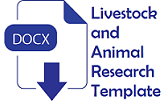Produksi karkas, nilai gizi dan profil asam lemak daging serta produksi limbah kelinci New Zealand White akibat penyertaan rumput laut cokelat (Sargassum sp.) pada ransum
Abstract
Objective: The aim of this current paper was to evaluate effect of inclusion Sargassum sp. in the ration on meat nutrient content, meat fatty acid profile and waste production of New Zealand White (NZW) rabbit.
Methods: Twenty four NZW rabbit (70-80 d old) with initial body weight 1736 ± 50 g were randomly allocated in to three treatments. The treatments were: T1 basal feed, T2 inclusion of 4% Sargassum sp. in the basal feed and T3 inclusion of 8% Sargassum sp. in the basal feed.
Results: Results of this experiment showed that inclusion of Sargassum sp. in the ration gave no effect (P>0.05) on the moisture, ash, crude protein content of Longisimus dorsi (LD) muscle, carcass percentage, warm carcass weight, cold carcass weight and waste production. However, the treatment was significantly (P<0.05) decreasing fat content of LD muscle. Fatty acids profile of all treatments was relatively same.
Conclusions: Utilization of Sargassum sp. in the rabbit ration up to 8% has no impact on the carcass production, protein, ash, and meat water content, and the waste production. Even the inclusion of Sargassum sp. the ration at level of 4% can reduce the fat content of rabbit meat. Thus, based on the observed parameters Sargassum sp. can be used to substitute rabbit feed up to a level of 8%.
Keywords
Full Text:
PDF (Bahasa Indonesia)References
- Hernàndez, O.J.A., and R. M. S. Lozano. 2001. Effect of breed and sex on rabbit carcass yield and meat quality. World Rabbit Sci. 9(2):51-56. DOI: https://doi.org/ 10.4995/wrs.2001.445
- Mailafia, S., Onakpa, M.M., and Owoleke O.E. 2010. Problems and prospects of Rabbit production in nigeria – A Review. Bayero J. Pure Appl. Sci., 3(2): 20-25.
- Dalle Zotte, A. 2002. Perception of rabbit meat quality and major factors influencing the rabbit carcass and meat quality. Livest. Prod. Sci. 75:11-32. https://doi.org/10.1016/ S0301-6226(01)00308-6
- Akande, K.E. 2015. Dietarry effect of increasing level of pigeon pea meal on rabbit performance. J. Agric. Sci. 7(7):156-162. Doi:10.5539/jas.v7n7p156.
- Hambakodu, M., E. Pangestu, dan J. Achmadi. 2019. Substitusi rumput gajah dengan rumput laut coklat (Sargassum polycystum) terhadap produk metabolisme rumen dan kecernaan nutrien secara in vitro. Jurnal Ilmu-Ilmu Peternakan 29(1):37-45. DOI: https://doi.org/10.21776/ ub.jiip.2019.029.01.05
- Budhiyanti, S.A., S. Raharjo, D. W. Marseno, and I. Y. B. Lelana. 2012. Antioxidant activity of brown algae Sargassum species extract from the coastline of Java island. American J. Ag. Biol. Sci. 7(3):337-346. doi:10.3844/ajabssp. 2012.337.346.
- Marín, A., M. Casas-Valdez, S. Carrillo, H. Hernández, A. Monroy, L. Sanginés, and F. Pérez-Gil. 2009. The marine algae Sargassum spp. (Sargassaceae) as feed for sheep in tropical and subtropical regions. Rev. Biol. Trop. 57 (4):1271-1281.
- Matanjun, P., S. Mohamed, N. M. Mustapha, and K. Muhammad. 2010. Nutrient content of tropical edible seaweeds, Eucheuma cottonii, Caulerpa lentillifera and Sargassum polycystum. J, Appl. Phycol. 21:75-80. https://doi.org/ 10.1007/s10811-008-9326-4.
- Cheeke, P.R. 1987. Rabbit feeding and nutrition. Academis press Inc, Orlando, San Diego, New York, Austin, Boston, London, Sydney, Tokyo, Toronto.
- AOAC. 1990. Official methods of analysis (13th Ed). Association of official analytical chemist Inc. Washington Dc.
- Holland, B., A.A. Welch, I.D. Unwin, D.H. Buss, A.A. Paul, and D.A.T. Southgate. 1998. The composition of foods. London: The Royal Society of Chemistry.
- Gomez, K.A., A.A. Gomez. 2007. Prosedur statistik untuk penelitian pertanian. Diterjemahkan oleh Sjamsuddin E and Baharsjah JS. UI Press, Jakarta.
- Al-Dobaib, S.N. 2010. Effect of diets on growth, digestibility, carcass and meat quality characteristics of four rabbit breeds. Saudi J. Biol. Sci. 17:83-93. https://doi.org/ 10.1016/j.sjbs.2009.12.012.
- Pla M, M. Pascual, and B. Ariño. 2014. Protein, fat and moisture content of retail cuts of rabbit meat evaluated with the nirs methodology. World Rabbit Sci. 12(3):149-156.
- Dalle Zotte, A. 2000. Main factors influencing the rabbit carcass and meat quality. In: Proceedings of the 7th world rabbit congress, Valencia Spanyol, 4-7 July. pp. 10-15.
- Milisits G., Romvári R., Szendro Zs., Masoero G., Bergoglio G. 2000. The effect of age and weight on slaughter traits and meat composition of pannon white growing rabbits. In: Proceedings of the 7th world rabbit congress, Valencia Spanyol, 4-7 July. pp. 629-634.
- Grashorn, M.A., J. Zimmermann, and W. Bessei. 1996. Meat quality features of light and heavy types of New Zealand White rabbits. In: Proceedings of the 6th World Rabbit Congress, Toulouse, France, 9-12 July. pp. 173-175.
- Sugiharto, S., E. Widiastuti, I. Isroli, T. Yudiarti, T. A. Sartono and H.I. Wahyuni. 2019. Breast meat characteristics of broilers fed fermented mixture of cassava pulp and Moringa oleifera leaf meal. J. Indonesian Trop. Anim. Agric. 45(2):103-114. DOI: 10.14710/jitaa.45.2.103-114.
- Hernàndez, P., A., and Dalle Zotte. 2010. Influence of diet on rabbit meat quality. In: Nutrition of the rabbit. Edited by C. de Blas, Univesidad Poletenica, Madrid. pp 163-178.
- Dalle Zotte, A., and Z. Szendrő. 2011. The role of rabbit meat as functional food. Meat Sci. 88:319-331. https://doi.org/ 10.1016/j.meatsci.2011.02.017
- Whitney, E.N., R.S. Rolfes. 2002. Understanding nutrition (9th ed.). Belmont, CA: Wadsworth/Thomson Learning.
- Hoover, W.H., and R. N. Heitmann. 1972. The Journal of Nutrition 102:375-379.
- Carabaño M.J.R., F.G. Santomá, and J.C. de Blas. 1988. Effect of diet on composition of cecal contents and on excretion and composition of soft and hard feces of rabbits. J. Anim. Sci. 66:901–910. Doi: 10.2527/jas1988.664901x
- Møller, H.B., S.G. Sommer, and B.K. Ahring. 2004. Methane productivity of manure, straw and solid fraction of manure. Biomas Bioenergy. 26:485-495. Doi: 10.1016/j.biombioe.2003.08.008
Refbacks
- There are currently no refbacks.










